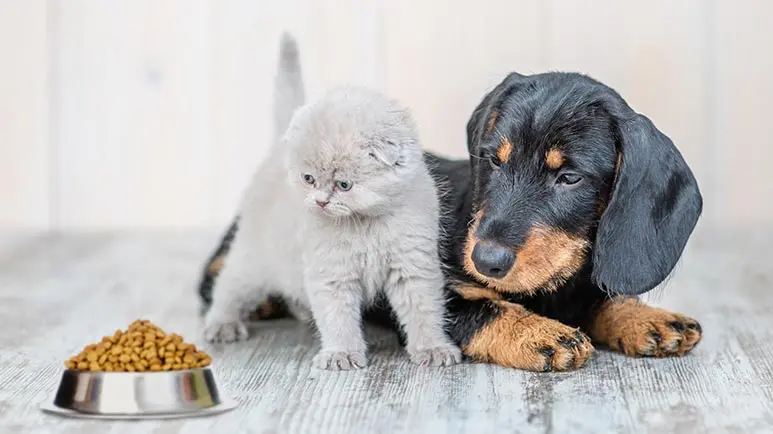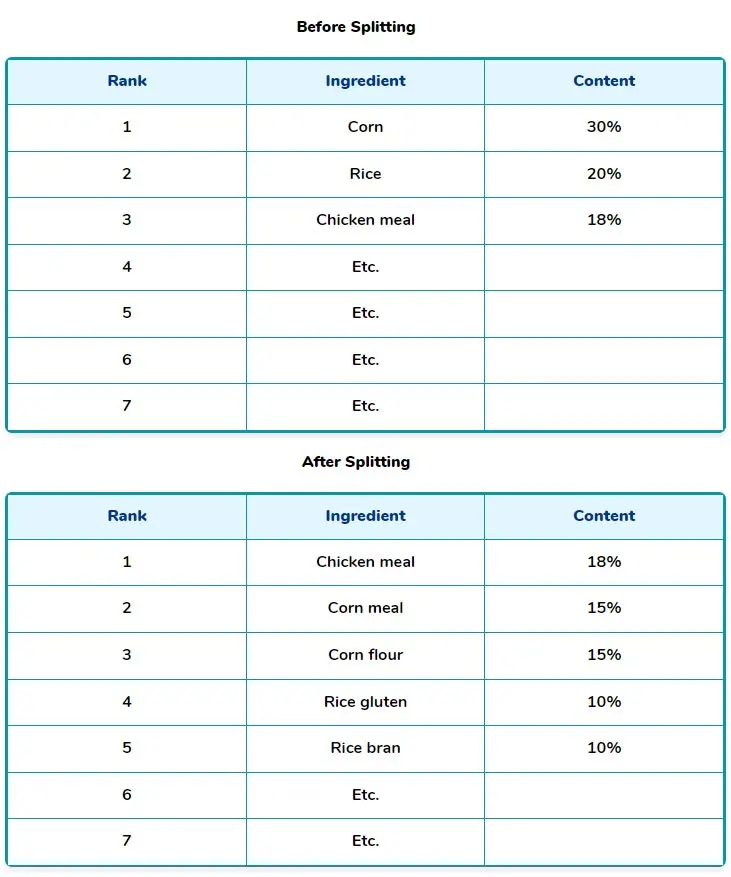The Tricks Pet Food Makers Use to Fool You
It's becoming increasingly difficult to know what's in that bag of food or treats, especially as owners demand food that looks more like their own. Here's how pet food makers are pulling out the stops to produce food that may look more homemade but isn't. Don't fall for their trickery.

STORY AT-A-GLANCE
- One of the latest processed pet food industry’s tricks of the trade is giving extruded pet food and treats, manufactured in huge quantities, the appearance of being homemade
- Big pet food employs all manner of manipulations designed to depict their rendered, extruded, ultraprocessed products as something much more appealing than they really are
- If you’re a pet parent, it’s important to avoid being fooled by pet food that looks handmade (but isn’t), claims to contain more meat than filler ingredients (but doesn’t) and a myriad of other deceptions designed to dress up inferior pet diets
Editor's Note: This article is a reprint. It was originally published January 10, 2021.
I came across a headline in a pet food industry journal that was surprisingly candid and at the same time disturbing: “Tricks to make extruded pet food, treats look homemade.”1 In the subheading, the author states, “Extruder operators can manipulate their machines to make mass produced pet foods look like they came out of a small batch oven.” For the uninitiated: tricks and manipulation are the status quo in the ultraprocessed pet food industry.
I could offer my own translation of these statements, but it’s really not necessary, since the author comes right out with it, blatantly encouraging the use of trickery and manipulation to make pet food look like something it isn’t in the eyes of pet parents.
As the article’s author points out, extruded pet food and treats (which I’ll explain shortly) are produced in huge quantities, and the end result is highly refined kibble and preformed treats that are very obviously manufactured in an industrial setting.
According to the author, consumers are demanding pet foods that look like their own “artisanal eats” (foods made by hand or by traditional methods), and as luck would have it, extrusion machines can be manipulated to make their high-volume, cookie-cutter yield look like it was baked in a small batch oven.
The author goes on to give a few technical examples of how adjustments to extruding machines can be used to create the illusion of handmade or homemade pet food.
Rendering and Extrusion, or ‘How the Sausage Gets Made’
The vast majority of ultraprocessed commercial pet food — including premium brands and so-called “prescription” and “therapeutic” diets — are made from rendered ingredients. The following is a description of the type of raw product pet food renderers deal in, from a 2004 report to Congress (the last I could find):
“Renderers annually convert 47 billion pounds or more of raw animal materials into approximately 18 billion pounds of products. Sources for these materials include meat slaughtering and processing plants (the primary one); dead animals from farms, ranches, feedlots, marketing barns, animal shelters, and other facilities; and fats, grease, and other food waste from restaurants and stores.”2
Renderers drive around in specially designed trucks picking up dead farm and ranch animals, as well as dead pets from animal shelters. They also collect fat, used restaurant grease and other human food waste (including expired meat, dairy and perishable grocery items) from food outlets that goes into pet food.3 You can view pictures of rendering facilities here and here.
The rendering process involves combining the raw product described above in huge containers and grinding the mixture down to chips or shreds. The mixture is then cooked at 220º — 270ºF for up to an hour, which separates the meat from the bone.
The grease, also called tallow, rises to the top, is skimmed off the mixture, and often becomes the mystery “animal fat” frequently found on pet food ingredient labels. The remaining product is put in a press that squeezes out all the moisture and pulverizes the material into a powder. Shaker screens are used to separate excess hair and large bone chips from the powder. The result is meat and bone meal added to pet food formulas.
If the bones going into the rendering vat contain heavy metals or chemical contaminants, they are passed up the food chain via pet food. Additionally, the mineral content of each batch of meat and bone meal varies, depending on species, nutrient intake and age at time of slaughter. This means there are widespread variances when it comes to the amount of minerals in each batch produced, making consistency impossible.
Extrusion is a process that has been used by the pet food industry for decades. About 95% of dry pet diets are manufactured using this process.
Batches of dog or cat food ingredients (including meat and bone meal from the rendering process described above) are mixed, sheared and heated under high pressure, forced through a spiral shaped screw and then through the die of the extruder machine. The result is a ribbon-like product called extrudate that is knife-cut and dried.
The high temperature used in extrusion (up to 400°F) and the short time frame to process (under 5 minutes) creates continuous chemical and physical changes to the ingredient mixture. These changes include starch gelatinization, inactivation of nutritionally active factors (including health-promoting substances like enzymes and polyphenols), protein denaturation, fatty acid degradation and vitamin loss.
The nutrient loss that occurs during the multiple high-heat processing steps required to produce kibble is substantial, and why so many of the items on dry pet food ingredient lists are vitamins that must be added back in after the manufacturing process.
Unfortunately, very few of the cofactors found in raw foods that are needed for overall vitality (including beneficial microbes, enzymes, fatty acids and polyphenols) are not routinely added back, and certainly not in the quantities found in fresh, whole foods.
The end result is fast food that is devoid of beneficial whole food constituents found in unadulterated raw food. What has been added to the food are several unwanted and very unhealthy processing byproducts. Maillard reaction products (MRPs) occur when proteins, carbs and fats are processed at high temperatures, creating immune disrupting and cancerous byproducts like heterocyclic amines, acrylamides and advanced lipoxidation end-products.
The question I hope you’re asking yourself right about now is, “Do I really want to be duped into buying a pet food containing rendered ingredients that someone has dressed up to look like it wasn’t spat out of an extrusion machine by the ton?” Kettle-cooked potato chips may look less processed and taste different than other brands of potato chips but they’re still potato chips, and they all result in the same metabolic consequences.
Pets Have Grown Progressively Sicker Eating Convenience Food
The conventional pet food industry serves a purpose in that it meets the demand for convenience pet food/feed at price points most pet owners can afford. A hundred years ago, most animal companions were fed primarily raw meat scraps and table leftovers, plus whatever food they hunted for themselves.
Unfortunately, since the introduction of commercial pet food back in the 1920s, and especially with the arrival of mass-market kibble around 1960, obesity and diet-related disease rates in dogs and cats have skyrocketed.
Instead of taking an honest look at how ultraprocessed diets might be contributing to the epidemic of health problems in companion animals, the biggest players in the pet food industry seem primarily focused on positioning products to hide their shortcomings, even as more and more consumers look to alternative diets to help their pets heal or stay healthy.
Offering tips to extruder operators on how to make food that is most definitely not made by hand look handmade is just one more manifestation of the industry’s focus on form over substance.
Ingredient Splitting, or How Corn Turns Into Chicken
Perhaps one of the most egregious examples of how big pet food manipulates the reality of their products is through ingredient splitting4 — a bit of trickery used to make the ingredient label on a bag, can or pouch of food more appealing to pet parents. Let’s say we have a dog food that’s primarily made with corn and rice, which is quite common in low-quality, inexpensive brands.
Corn and rice are significantly less nutritious for dogs than meat (actually, they aren’t even in the same ballpark), making them inferior ingredients.

Look at the ingredients in this dog food “Before Splitting.” It’s quite clear corn is the predominant ingredient, followed by rice. Chicken meal, presumably made from chicken meat and other chicken pieces and parts, which is what many pet parents look for at the top of the list, comes in third.
However, as you can see in the “After Splitting” example, when the manufacturer gets a little creative, using a couple of different corn and rice products, he can list them separately (split them), and lo and behold, chicken meal pops to the top of the list, which is enough to convince many pet owners the food is meat-based and high quality.
My fellow pet nutrition advocate, Rodney Habib, exposes another gimmick the industry doesn’t talk about called the Salt Divider, in this Facebook Live video.
What to Do If You’ve Lost Trust in the Conventional Pet Food Industry
Thanks to mislabeled products, deceptive marketing techniques, poor-quality ingredients, too-frequent recalls, and an exploding population of pets with chronic digestive issues, allergies and degenerative disease, it's no wonder so many pet parents are exploring homemade diets, fresh food diets made by smaller, transparent pet food producers, raw diets (some of which are sterile) and other alternatives to the dead, rendered, dubious, ultraprocessed feed-grade “fast food”.
My advice? Search this website for more information on choosing the best diet for your pet. There are dozens of videos and articles here that can help you become more knowledgeable about pet nutrition so that you can make the best diet choices for your own dog or cat. You can also learn what real transparency in pet diets looks like by ordering the Truth About Pet Food 2024 List.
If you want to help change the deceptive practices occurring in the pet food industry, I recommend becoming a member of the Association for Truth in Pet Food, which is the only organization out there committed to holding the regulatory agencies and AAFCO accountable. You can also check this list for the pet food companies that have taken the ingredient transparency pledge.











